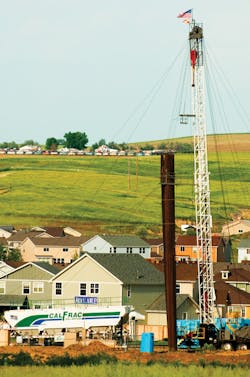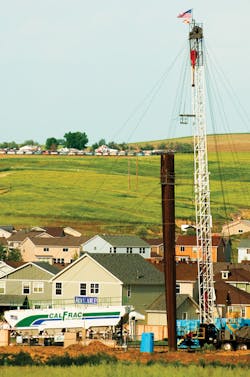Colorado communities collaborate with operators
Tayvis Dunnahoe, Exploration Editor, OGJ
WELD COUNTY, Colo.—Drafting a memorandum of understanding (MOU) is a middle-of-the-road solution some communities use to address the health and safety concerns of residents living near unconventional development areas.
Some communities in Colorado are working closely with operators through development of memorandums of understanding (MOUs). Photo by Encana Corp.
In early November, several Colorado communities voted on measures to ban hydraulic fracturing. In Broomfield, the town residents passed the ban by a slim margin. Fort Collins succeeded with 56% in favor of a five-year moratorium, which was nearly a ten-point drop from 65% in earlier polling this year. According to many reports, the bans enacted in the cities of Lafayette and Boulder were symbolic as neither town has seen new oil and gas activity for many years.
Despite the outcome of these elections, Colorado's D-J basin has been home to oil and gas exploration for several decades. With the continued development of the Niobrara formation in Colorado's front-range, some municipal governments have worked collaboratively with operators within the last year and a half to establish MOUs to find a rational balance between oil and gas operations and local community concerns.
Understanding development
Approximately 30 miles north of Denver, the City of Erie, Colorado, is a rapidly growing community of about 21,000 people. The city's primary demographic consists of young, affluent families who are fairly well educated, according to Town Administrator A.J. Krieger.
Erie is currently in the early stage of comprising an overall economic development plan. Land use consists primarily of single family residences. "Erie is served by two high-performing school districts, St. Vrain Valley and Boulder Valley," Krieger said. With acres of open space and miles of trails, Erie is an attractive community for young families. "We're a community that offers a very high quality of life."
In around 2010, Erie residents expressed concerns to the City Council about several oil and natural gas wells being drilled near the town. "The origin of our MOU began as a way to balance what seemed like competing interests," Krieger said. Amid calls from an active citizens' group to ban fracing within the limits of the town, Krieger describes the need to address health concerns while also fostering economic growth from increased oil and gas operations as a "public policy perfect storm."
"Erie Rising, as the citizens group is known, consists of many young mothers," Krieger explained. "It was a sympathetic group that at times offered a somewhat compelling case."
As a town government, Erie's Board of Trustees shared the dual responsibility of not only protecting public health and safety, but also respecting individual property rights. In a number of cases throughout North America, some municipalities have enacted bans against procedures such as hydraulic fracturing. One of the first of its kind, Erie solved its operational concerns through the development of an MOU with both Anadarko Petroleum Corp. and Encana Oil & Gas (USA) Inc. In effect for 14 months of its 3-year term, the agreement is binding and works in conjunction with the state's regulatory and permitting authority, Colorado Oil and Gas Conservation Commission (COGCC). All parties have expressed a preference for a collaborative solution over litigation.
Sifting through the noise
In Colorado, oil and gas development is considered a statewide concern. In several test cases, COGCC has been validated as the governing authority of oil and gas operations. As seen through several recent votes in neighboring communities, locally enacted moratoria are what Krieger referred to as "recipes for litigation." Finding a solution to Erie's concerns involved education and independent research. "We did not want to advocate for environmental activists, and at the same time we did not want to solely protect the interests of oil and gas companies over those of our constituents," Krieger said. One of challenges according to Krieger was sifting through the noise. "There is no shortage of people and institutions willing to provide you with more information than can possibly be digested on the topics of hydraulic fracturing and its possible risks," Krieger said. Understanding the motivation and the validity behind each source helped the town's government devise a laundry list of concerns where risks could either be monitored or averted through the application of technology.
"We decided a down-the-middle approach would be one that responds to residents' needs and concerns, but would also respect the rights of operators to continue doing what they have a legal right to do," Krieger said. "These companies employ a lot of people in and around this region, so they're an important part of the state's long-term economic development," Krieger added.
Terms and conditions
The process to develop Erie's MOU took 8 months. The final document, ratified in August 2012, represented a long-term collaborative effort that involved input from environmental groups, oil and gas operating companies, the town's government, and COGCC, which now acts as the MOU's enforcement arm.
By the agreement, operators must adhere to the best management practices established in the MOU before COGCC approves the drilling permit. In many cases, the additional practices are already carried out in standard operations. Although, adding these as conditions of approval provided confidence within the community as they are overseen by COGCC.
Drinking water supply is now monitored by the town at both the reservoir and at intake sights on the facility level. "To date, constant monitoring has shown no drinking water problem, and we share this information with our residents," Krieger said.
The MOU also addressed air quality by establishing that wells drilled within the town's limits would use vapor recovery units and additional emission-control equipment to capture fugitive emissions. While this application is not currently a requirement for permitting statewide, many operators such as Anadarko and Encana typically control fugitive emissions in standard operations.
Truck traffic was also a concern that most residents expressed. Hydraulic fracturing typically increases traffic on local roadways based in part because of the amount of water transported. As a solution to decrease truck traffic, the MOU established rules for operators to purchase water directly from the City of Erie when an accessible source was nearby rather than transport the water to well sites using trucks. Last summer Encana estimated that it had avoided 1,000 truck trips using this option.
While the MOU has functioned as smoothly as it was designed, there are other benefits derived from local involvement in the permitting process. One by-product, according to Krieger, is the increased contact between operators and the local government. "We have a very responsive relationship with these operators, and they have been more than willing to address any questions we may have," Krieger said.
For Erie, the MOU has provided a framework for developing industry in close proximity to the town. Rather than resist continuing oil and gas development, the town's agreement with Anadarko and Encana has created a collaborative environment that removes some of the roadblocks that plague similar communities in other parts of the state.
An operator's perspective
Encana has operated in Erie and the surrounding area since 2006. Currently, Encana has wells on production in Erie, but has no active drilling in the town. The company produces oil and gas from the Niobrara and the J Sand formations. It participated in Erie's MOU process after one location drew attention because some residents believed it to be too close to a school. At the time, setback requirements were 350 ft, and the rig in question was actually 1,200-1,300 ft from the school. As a result, more questions began to surface about the process of hydraulic fracturing and a dialogue began between operators and the town of Erie. "This was one of the issues that led us to seek middle ground with the town of Erie," said Encana Community Relations Lead for D-J basin Wendy Wiedenbeck. "The MOU was a new concept, a new idea."
Part of the appeal of an MOU is that it challenges the current notion that municipalities and oil and gas producers cannot find ways of working together. "We can and we should," Wiedenbeck said. "As operators, we have a responsibility to listen to community concerns."
In the case of Erie, the MOU was the product of a reasonable dialogue about oil and gas operations and their impact on the community. It called for meaningful additions to normal operations and found common ground between landowners, community members, and resource developers. A major concern for Erie's residents in the early development of the MOU was the lack of enforceability, and the belief that the industry was not heavily regulated. The agreement from COGCC to sign off on the best management practices listed in the MOU provided more confidence for the local community. "The MOU called for meaningful additions to normal operations that have provided a common ground between our operations and community," Wiedenbeck said.
"You're never done communicating with the communities where you are operating," Wiedenbeck said. COGCC established new rules in early 2013 that require operators to engage local municipalities much earlier in the development phase to provide more time for public comment. Companies like Encana view these as high-value engagements. "If a community is caught by surprise or does not know anything about our industry, then we haven't done our job," Wiedenbeck said.
Regardless of an MOU, newer technology helps companies improve the safety of their operations. "Incorporating strategies in one area ultimately affects how we operate in other areas," Wiedenbeck said. "We continue to adopt new technology as it becomes available."
A new trend?
Every community is unique, and what is important to one may not be crucial to another. The benefit of an MOU is that it can bring operators and communities together to find solutions geared toward the specific needs of a given community.
In August 2013, the City Council of Broomfield, Colo., entered into an MOU with Sovereign Operating Company LLC. The agreement essentially added 30 new requirements over the standard permitting practice for Colorado. Many residents at the time felt the City Council had overreached its authority. Just prior to the signing of this MOU, a petition had been filed to place a fracing moratorium on the ballot for November, which was approved by a narrow majority.
According to the official document, the company's agreement with Broomfield involves 10 wellsites, which includes existing approved wells and pending or proposed development wells. Among the best management practices listed in the document, provisions were outlined to prevent fugitive emissions, provide protective berms and closed-loop (pitless) drilling systems, and permission to conduct spot inspections with 48 hours' notice to the company. In addition, any new proposed wells not listed in the original MOU would require mandatory townhall meetings prior to issuance of a permit.
Other communities in Colorado are taking similar approaches to get more involved in the development of oil and gas resources within their borders, yet it is not clear whether this trend will expand. In Longmont, Colo., rules were adopted locally that, according to local sources, effectively banned fracing altogether. Due to the operational status of its rule making, the city is now in litigation with the State of Colorado.
Colorado is unique in its structure, as the state regulatory authority over oil and gas operations is well supported by legislation and case law. The same takeaways from the current trend may not apply to other regions, and it is difficult to know how this trend could play out in other states.
Erie's MOU was one of the first of its kind. Anadarko also was involved in the process, although the company has yet to develop any wells in the area. According to Susan Aldridge, senior counsel at Anadarko, "Municipalities have jurisdiction over land use." Communities can often express limited control with oil and gas sections in their zoning laws, but they cannot regulate from an operational standpoint. Erie's goal was to provide more protection slightly above the state permitting process. "Much of what they asked us to do was part of our voluntary best management practices already; the MOU simply codifies our willingness to go above and beyond," Aldridge said.
With Erie as a baseline, more communities are pursuing MOUs. However, Colorado has undergone many rule changes within the last year and a half concerning setbacks and best management practices throughout the entire D-J basin. It also has given local communities more say in how companies permit wells at the COGCC, and increased the opportunities for landowners and the general public to make comments. As a result, MOUs may be less important going forward because state regulations are becoming more robust. "Because the new state rules are more inclusive to public comments, what local governments have achieved with MOUs can now be overseen and enforced through the state permitting process if the municipality does not want to embark down a path towards an MOU," Aldridge said.
In the example of Broomfield's MOU, there is a significant crossover into COGCC's current regulations, which is validated through engineering expertise at the state level. Without industry knowledge and experience, local communities are often unable to address the technical aspects related to oil and gas operations in conjunction with other community concerns. Rather than MOUs becoming more elaborate and potentially running into problems associated with usurping state authority, many communities may begin developing MOUs to define requirements for land uses that can be regulated at the local level.
The road ahead
"What we're finding is that many jurisdictions are now beginning to trust the state permitting process," Aldridge said. The function of an MOU is to provide more interaction with local communities throughout the development process.
"We go out of our way to address the concerns of local governments and their residents, and we always want enforcement to lie with the state." Aldridge said. Robust state regulatory schemes work for both the industry and the public. To the extent local governments want to be involved, appropriately drafted local land use regulations and/or MOUs can generate a positive outcome. Rather than attempt to develop oil and gas regulations at the local level, many communities are applying authority more effectively by relying on state regulations and improving land use through local legislation or an MOU.




